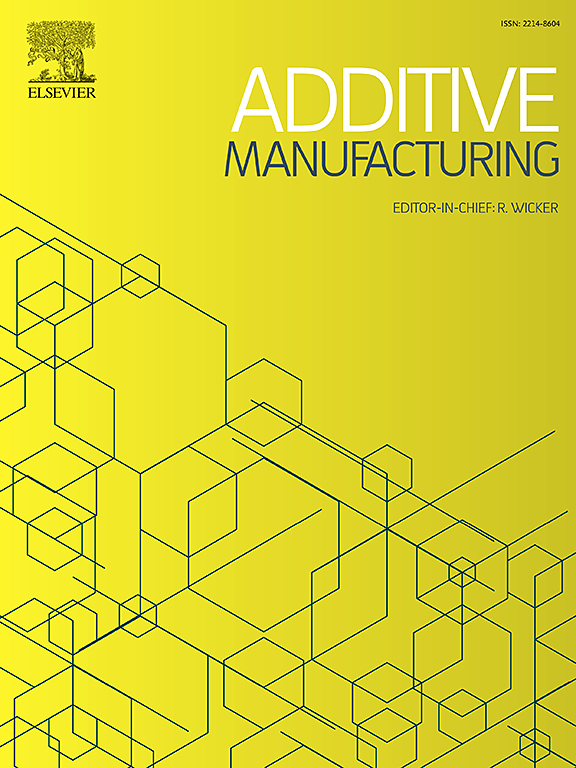Modeling of the high-viscosity fluid transient flow for material deposition in direct ink writing
IF 10.3
1区 工程技术
Q1 ENGINEERING, MANUFACTURING
引用次数: 0
Abstract
A transient flow model is developed to predict the flow of high-viscosity fluid dispensing for precision direct ink writing (DIW) in additive manufacturing. Models for pump deformation and fluid friction to accurately predict flow of a high-viscosity non-Newtonian fluid through a progressive cavity pump, static mixer, and a tapered nozzle are created. Inside the progressive cavity pump, the effect of elastic deformation on modeling high-viscosity fluid transient flow is included. Based on the Characteristic Method (CM) and boundary conditions for DIW, the continuity and momentum equations are numerically solved. Using deformation modeling and CM, the transient response of the DIW system to the input volumetric flow rate is modeled for both a pipe and static mixer. The transient response of the DIW output volumetric flow rate is recorded using flow and pressure sensors and found to match the flow model. The deformation and CM models are applied to predict the swelling of a 90° corner DIW tool path from trapezoidal motion planning with accelerations from 100 to 2000 mm/s2. Predicted corner swelling is matched with the actual corner swelling via image processing of the 90° corner. The corner swelling is significant, ranging from 0.76 to 0.37 mm for a line width of 0.25 mm and a height of 0.15 mm, and represents the model’s ability to quantify print errors. This study demonstrates that the flow model can accurately predict the transient response of the DIW volumetric flow rate, which is foundational to high-fidelity flow control and compensation in precision DIW.
直墨书写中材料沉积的高粘度流体瞬态流动建模
建立了一种瞬态流动模型,用于预测增材制造中用于精密直墨书写(DIW)的高粘度流体点胶的流动。建立了泵变形和流体摩擦模型,以准确预测高粘度非牛顿流体通过螺杆泵、静态混合器和锥形喷嘴的流动。在螺杆泵内部,考虑了弹性变形对高粘度流体瞬态流动建模的影响。基于DIW的特征法和边界条件,对连续性方程和动量方程进行了数值求解。利用变形建模和CM方法,对管道混合器和静态混合器的DIW系统对输入体积流量的瞬态响应进行了建模。利用流量和压力传感器记录了DIW输出体积流量的瞬态响应,并发现其与流动模型相匹配。应用变形模型和CM模型对加速度为100 ~ 2000 mm/s2的90°角直插弧焊刀路的梯形运动规划进行了膨胀预测。通过对90°角的图像处理,将预测的角膨胀与实际角膨胀进行匹配。当线宽为0.25 mm,高为0.15 mm时,角肿胀明显,范围为0.76至0.37 mm,这代表了模型量化打印误差的能力。研究表明,所建立的流量模型能够较准确地预测容积流量的瞬态响应,为实现高精度直埋管道的高保真流量控制和补偿奠定了基础。
本文章由计算机程序翻译,如有差异,请以英文原文为准。
求助全文
约1分钟内获得全文
求助全文
来源期刊

Additive manufacturing
Materials Science-General Materials Science
CiteScore
19.80
自引率
12.70%
发文量
648
审稿时长
35 days
期刊介绍:
Additive Manufacturing stands as a peer-reviewed journal dedicated to delivering high-quality research papers and reviews in the field of additive manufacturing, serving both academia and industry leaders. The journal's objective is to recognize the innovative essence of additive manufacturing and its diverse applications, providing a comprehensive overview of current developments and future prospects.
The transformative potential of additive manufacturing technologies in product design and manufacturing is poised to disrupt traditional approaches. In response to this paradigm shift, a distinctive and comprehensive publication outlet was essential. Additive Manufacturing fulfills this need, offering a platform for engineers, materials scientists, and practitioners across academia and various industries to document and share innovations in these evolving technologies.
 求助内容:
求助内容: 应助结果提醒方式:
应助结果提醒方式:


